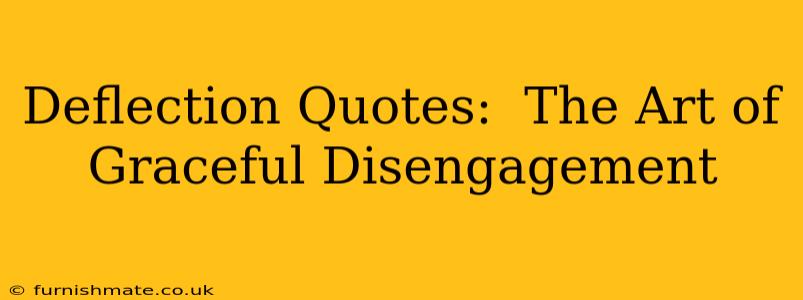Deflection. It's a word that often carries negative connotations, conjuring images of evasion and dishonesty. But used skillfully, deflection can be a powerful tool for graceful disengagement, a way to navigate difficult conversations and protect your emotional well-being without resorting to confrontation. Mastering the art of deflection requires tact, wit, and a deep understanding of both verbal and nonverbal communication. This post explores the nuances of deflection, providing examples of effective deflection quotes and strategies to help you navigate challenging situations with grace and composure.
What is Deflection in Communication?
Deflection, in the context of communication, is the art of subtly shifting the focus away from a potentially uncomfortable or unproductive topic without directly confronting or ignoring the issue entirely. It's about redirecting the conversation, often towards a more positive or neutral ground. It's not about lying; it's about skillful redirection. The key is to maintain respect and civility while protecting your energy and boundaries.
Why is Deflection Important?
In today's fast-paced and often emotionally charged world, the ability to deflect negative energy and gracefully disengage from unproductive conversations is invaluable. Deflection can help you:
- Protect your mental health: Constantly engaging in negative or draining conversations can take a toll on your well-being. Deflection allows you to prioritize your emotional health.
- Manage conflict effectively: Instead of escalating arguments, deflection can de-escalate tense situations and create space for a more constructive dialogue.
- Set boundaries: It's a subtle yet powerful way to assert your boundaries without being aggressive or confrontational.
- Maintain positive relationships: By choosing your battles and skillfully deflecting negativity, you can preserve important relationships.
Effective Deflection Quotes and Strategies
Here are some examples of effective deflection techniques, along with illustrative quotes and strategies:
1. Changing the Subject:
This classic deflection technique involves smoothly transitioning the conversation to a different, more agreeable topic.
Example:
"That's an interesting point, but I was just thinking about [new topic]. Have you seen [movie/show/article]?"
This quote subtly shifts the focus without directly dismissing the previous topic.
2. Acknowledging and Reframing:
Acknowledge the other person's feelings or concerns, but then subtly reframe the conversation in a different light.
Example:
"I understand your frustration, but I'm focusing my energy on [positive goal/action]. Let's talk about that instead."
This shows empathy while gently redirecting the conversation.
3. Using Humor:
Humor can be a powerful tool for deflection. A well-placed joke or witty remark can diffuse tension and gently steer the conversation in another direction.
Example:
"Oh, that's a tough one. I'd better stick to my knitting!" (said with a lighthearted tone)
This deflects the issue with humor and self-deprecation.
4. Seeking Clarification:
Asking for clarification can buy you time and create an opportunity to redirect the conversation.
Example:
"I'm not quite sure I understand what you mean. Could you explain that a little further?"
This gives you a chance to assess the situation and respond strategically.
5. Agreeing to Disagree:
Sometimes, it's best to simply acknowledge that you have different perspectives and move on.
Example:
"It sounds like we have differing opinions on this. I respect your perspective."
This concludes the conversation respectfully without engaging in a potentially unproductive debate.
Frequently Asked Questions (FAQs)
Is Deflection Always the Best Approach?
No. Deflection should be used judiciously. In situations requiring direct confrontation or serious issues, open and honest communication is essential. Deflection is most effective for navigating minor conflicts, negativity, or unproductive conversations.
How Can I Improve My Deflection Skills?
Practice makes perfect! Start by consciously identifying situations where deflection might be helpful. Experiment with different techniques and observe which ones work best for you. Pay attention to your nonverbal cues as well; your body language should reinforce your words.
Isn't Deflection a Form of Avoidance?
Not necessarily. While it avoids direct engagement with a specific topic, it’s not about ignoring the issue entirely. It's about choosing how and when to address a matter, prioritizing your well-being and creating a space for more constructive communication.
What are some situations where deflection would be inappropriate?
Deflection is not suitable for situations that require direct and honest responses, such as serious accusations, emergencies, or situations where someone needs immediate support or help.
Mastering the art of deflection is a valuable life skill. By learning to use deflection quotes and strategies effectively, you can navigate challenging conversations with grace, protect your emotional well-being, and maintain positive relationships. Remember, it's not about running away from problems, but about choosing your battles wisely and finding more constructive ways to engage.

